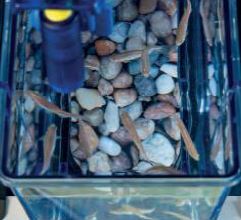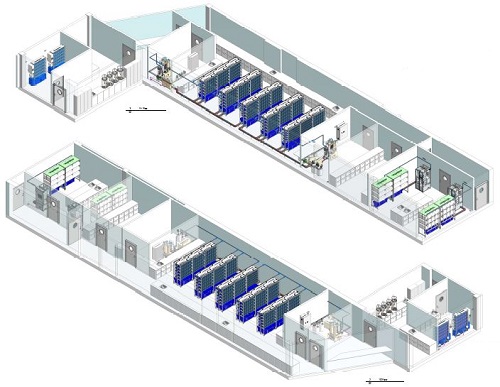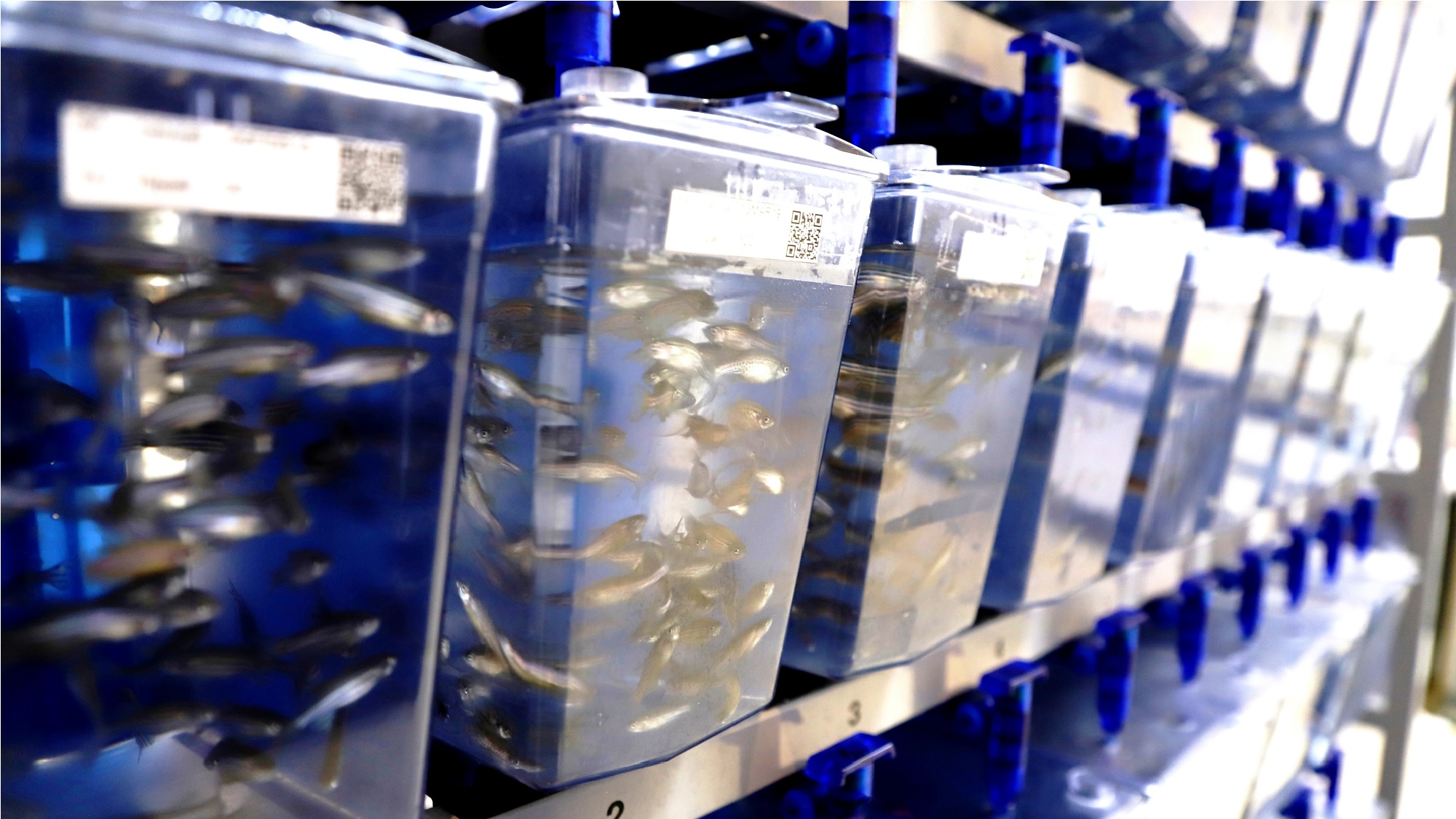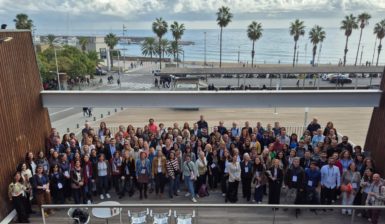In 2007, just after the inauguration off the Barcelona Biomedical Research Park (PRBB), the park’s aquatic animal facility opened its doors. With a surface area of 273 square metres, it became one of the largest and best equipped in southern Europe. However, after almost 20 years, the facilities that were once the ultimate in modernity now need to adapt to improve their functionality and relevance. In order to continue providing a high quality service to both PRBB research groups and external users and to introduce improvements in animal welfare, renovation work began in January and will last until 2026.
Currently, the animal facility is the only scientific and technical service managed directly by the PRBB Consortium. The other services, such as tissue engineering, mesoscopic microscopy or synthetic peptides, are managed by each centre and offered at a reduced price to all the groups in the park. The animal facility is therefore one of the core facilities of the PRBB. To ensure animal welfare and successful research, the aquatic animal facility has Laura Aranda Aguilera as the veterinary supervisor of the facility. In addition, 5 carers and 1 coordinator from Charles River Laboratories also work there, in charge of the care and maintenance of the animals.
The aquatic animal facilities today
The PRBB aquatic animal facility has housed around 16,500 specimens of Dario rerio, commonly known as zebrafish, and 240 Xenopus laevis frogs. It is divided into three very different rooms.
The first one, just next to the door, is the live diet room. At the PRBB, zebrafish are fed on dry food, a saltwater rotifer – a very small animal widely use in aquaculture – and artemia – a small crustacean. In this room, the carers keep the rotifer and the artemia population in the optimal conditions. This kind of feeding, so complete, makes the PRBB stand out. While other animal houses only feed their fish dry food and artemia, here they are also fed rotifer because it helps to improve the zebrafish development.
The second room is the main one and it has 52 racks with 60 tanks each. They are like shelves filled with fish tanks from top to bottom. They are connected in parallel to the water flow. In total, around 8,000 litres of water flow through the whole system. The tanks in the PRBB are either 1, 3 or 9 litre tanks. Each one of them has two stopcocks which are used to regulate the water flow and adjust it to the correct flow rate. This is not the only thing that needs to be kept under control. Small changes in water temperature, pH and the amount of nitrogen-based compounds in the water can wreak havoc on the quality of life of the fish and the experimental results. This is why constant monitoring of the water is one of the basic tasks of the staff at the PRBB aquatics facility. In the main hall there is also working space. Two of the walls are lined with tables so that the people researching and caring for the fish can handle them.
“The aquatic animal facility of the PRBB is at the forefront of animal care and management in Europe”
Laura Aranda Aguilera (veterinary supervisor)
In this same room, there is a small quarantine area. The fish that arrive from other institutions or companies outside the PRBB are housed there and checked for signs of disease, before being introduced into the main tank network. Once the external animals reach sexual maturity, only the offspring will be introduced into the main tank network. In this way, contamination from the outside and possible outbreaks that could affect all fish are avoided.
The third room is where the frogs are kept. The structure is the same as in the main room, but smaller. It has several racks with tanks where the animals live. The facilities are staffed every day of the year. With morning and afternoon shifts, the caretakers cover working days as well as weekends and public holidays. In the evenings, the PRBB keepers access the animal facility on their rounds and alert the caretaker on duty if there are any problems. With this three-way system, they ensure that they can react in time in case of mishaps and that the animals do not suffer the consequences. Laura says that “this is not common in facilities of the same style and it puts the PRBB aquatic animal facility at the forefront of animal care and management in Europe”.
Working on a transformative renewal
According to Laura, the main aim of this renovation is to improve animal welfare, improve experimental conditions and make the space more efficient and safer for both keepers and researchers.

When the animal facility was designed in the mid-2000s, it was expected to house far more animals than it does now. This has resulted in the space being oversized. Currently, only half of the tanks available for the fish are filled.
The large number of racks makes the aisles small and manoeuvring difficult. After the renovation, there will be 30 racks with 50 tanks each. The aisles between the racks will be enlarged and it will be possible to bring in trolleys to transport the tanks to the working areas.
The workspace will also be improved. The lab benches will be replaced by special aquatics furniture designed ad hoc to accommodate the needs of the PRBB. Apart from being made of waterproof material, it will be slightly sloped to channel water directly into the drainage system. For the same reason, a number of cross drains will be installed in the floor of the room.
The layout of the space will also change. Specific rooms will be added so that research staff can conduct their experiments and handle the animals more comfortably. A closed quarantine area will also be added, which will increase the biosecurity of the animal facility.

Finally, the entire rack system will be changed. It will go from having all the elements (spanners, nuts, tubes…) with American measurements to having them with European measurements. This will facilitate the constant maintenance of the installation and parts will be replaced more quickly in case of damage, which will result in an increase in the security and stability of the housing systems. This upgrade will also make the system more efficient and sustainable.
The control of pH, salts and nitrogen compounds will be done through sensors that will automatically diffuse the necessary compounds.
In addition, it will become a fully automated system. At the moment, the pH, salt and nitrogen-based compunds levels are measured manually every few months. The regulation of these is also done by hand, calculating the amount of chemicals needed and adding them to the water on the spot. The new system will have sensors that will monitor the levels and diffuse the necessary compounds automatically. This will prevent human error, reduce instability in the water parameters and relieve caretakers of some of the most tedious tasks.

The works in phases
The renovation is expected to take around 18 months. The works, which are made possible thanks to contributions from Ajuntament de Barcelona and the Generalitat de Catalunya, have a cost of 2.3 million euros and will be completed in three different phases.
1. Provision of a temporary aquatic animal facility
In order to preserve the zebrafish lines located in the PRBB, sometimes unique in the world, and to continue with the ongoing research while the facilities are being renovated, a smaller temporary animal facility will be set up for them. The frogs, on the other hand, will be housed in the animal facility of a collaborating centre. This temporary space is currently under construction and will already have one of the new sets of racks with the automated system. The construction of this biomodule and the transfer of the fish are estimated to last until approximately August.
2. Complete renovation of rooms
During this stage, the main work will be carried out with the structural changes to the rooms: installation of the sanitation and the lab benches and the quarantine and working rooms. At that time, additional new racks will be installed. This phase will take place in the last quarter of 2025 and is expected to be completed during January 2026.
3. Dismantling of the temporary animal facility
The fish will be introduced into the new room (between February and June 2026, approximately) and the racks and water treatment systems from the temporary animal facility will be installed in the permanent one. It should be borne in mind that, with each relocation, the fish need time to acclimatise so as not to compromise their welfare. They will not all be moved at the same time, but every week, a few will be moved until they are all in place. This stage is expected to be completed by the summer of 2026, when the temporary biomodule will be dismantled.
Each of the phases will be strictly controlled. The European directive on animal research and animal care is very strict. During these months, the animal facility will be audited by different bodies to certify that the facilities are correct. The PRBB animal facility is accredited by the international Association for Assessment and Accreditation of Laboratory Animal Care (AAALAC), which recognises the high quality of its services.
During the duration of the works, the animal facility will be audited by different organisations to certify that the installations are correct.
Fish and frogs, research on the rise
When one thinks of animal research, the first thing that comes to mind is white mice. Because of their characteristics, mice have been one of the most widely used animals in research. Increasingly, however, the use of species that are less neurophysiologically sensitive, i.e. less pain-sensitive, while still allowing relevant results to be obtained, is being advocated for. Thus, although mice remain the most researched animal, other less complex species are gaining ground.
Zebrafish originate from Southeast Asia. They are used because they reproduce easily and quickly, grow at high speed, share 70% of their genome with humans and are transparent during the embryonic process, which favours their manipulation. On the other hand, eggs and tissue from female Xenopus frogs are very valuable in studies of reproduction and cell biology because they are easy to manipulate, allow the recreation of processes such as cell division in vitro and the study of phenomena such as ovogenesis, the cell cycle and microtubule dynamics. Their use has facilitated the identification of key proteins and is a versatile model for developmental biology research.
“The renovation of the PRBB’s aquatic animal facility, combined with the experience of our staff, places us at the forefront in Europe and reflects our ongoing commitment to excellence and innovation in the life sciences field.”
Joan Antoni Fernández Blanco, Director of the Animal Facility
The current renovation of the aquatic animal facility will ensure the welfare of these animals to continue advancing research. It will also improve the comfort and safety of carers and research staff. In the words of the animal facility director: “The renovation of the PRBB’s aquatic animal facility, combined with the expertise of our staff, places us at the forefront of biomedical research in Europe. This advancement not only improves animal welfare and research quality, but also reflects our ongoing commitment to excellence and innovation in the life sciences”. With state-of-the-art facilities, the PRBB animal facility will offer cutting-edge services for the development of biomedical research.







